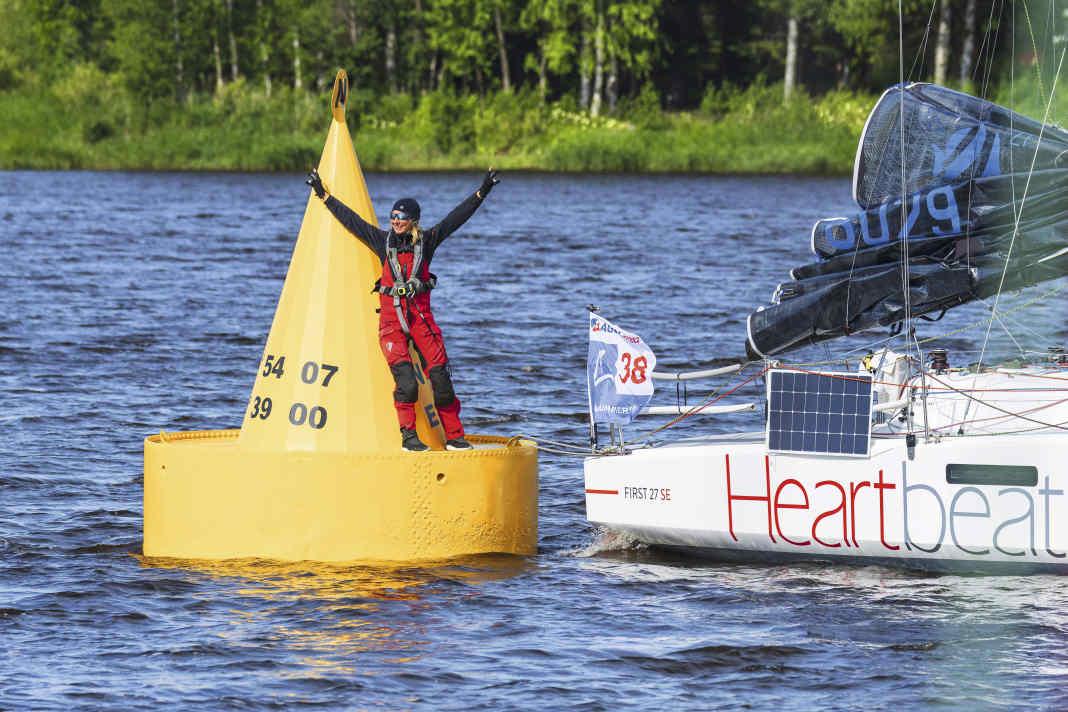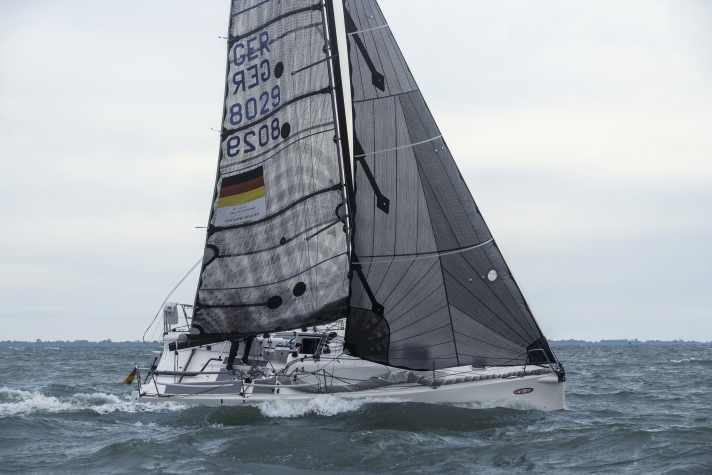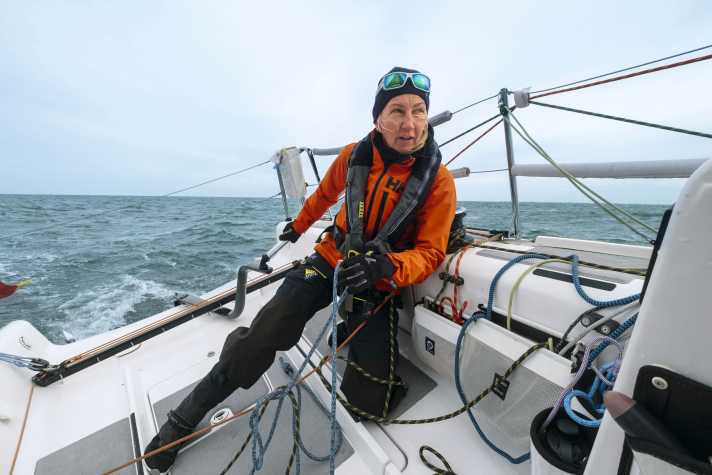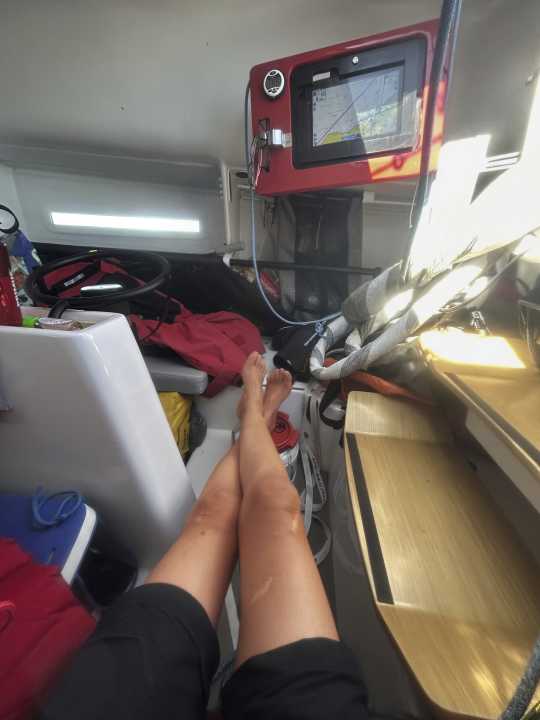





"Sailing? Never again!" Wilhelmshaven resident Marlene Brudek agrees with the person sitting next to her on a bench on the jetty in Heligoland harbour in the early summer of 2017. Behind the chance companions lies a first berth charter trip on the North Sea with an inexperienced skipper. With the mainsail reefed over-cautiously and stubbornly flat in front of the sheet, the boat rolled on a straight course to Helgoland - with a seasick crew and a broken rudder halfway there. The beautiful dream of sailing did not stand up to the reality test; never setting foot on a sailing boat again is the logical reaction.
But in summer 2024, the same woman will be standing on the yellow post buoy in Töre at the end of the Gulf of Bothnia with a beaming smile. Single-handed and with the smallest boat in the fleet of participants, her First 27 SE "Heartbeat", the 55-year-old has completed the MidsummerSail, her biggest challenge to date. Nine days and 20 hours alone at sea, with lulls and fog, but also strong winds in which her small, light boat does not go through the waves, but bounces over them. Permanently in oilskins, at the mercy of wind and water.
Marlene Brudek and her First 27 SE "Heartbeat"

The Beneteau First 27SE is the ideal boat for the Wilhelmshaven-based regatta enthusiast: at just under eight metres in length, it is suitable for single-handed sailing and offers sufficient space and spartan equipment for longer trips. A draught of two metres gives the fast glider with its 80 m² genacker stability; with an electro-hydraulically raised swing keel, it can be trailered and goes over shallows in tidal waters. Designed to reduce weight at all times, the boat weighs just 1.7 tonnes. The tech-savvy owner has trimmed it for maximum single-handed capability and safety with additional blocks and furlers, autopilot, Orca navigation system and fuel cell, Epirb and life raft.
On the large yachts that pass her by, crews of several people sit with a steaming mug of coffee protected under the sprayhood, betting that this unit of woman and boat, neither of which looks particularly robust, will never manage the longest and toughest regatta in the Baltic Sea.
Holistic sailing concept in the Seascape family
And indeed: "When you look behind you and see a wave of easily 3.50 metres breaking behind you - holla!" says the skipper after the race. "It occurred to me that the boat, with its 30 centimetres of freeboard and open stern, was slowly reaching its limits." But the First 27 easily coped. "With the second reef in the main and without a headsail, we roared down the wave at 13 knots!" Her eyes light up in a little adrenaline flashback.
Seascape boss Andraz Mihelin comments after the race with a twinkle in his eye: "And she also has a regular job. I hate it when people pick apart my excuses for not being able to go sailing like that." She has set a whole new standard for the Seascape family, with whom she also regularly competes in class regattas. Behind this is a holistic sailing concept that is otherwise only practised by professionals.
Find out where the limits are and start from there."
Between the day on the Helgoland breakwater and the one on the yellow buoy at the end of the Gulf of Bothnia, there are plenty of regattas, most of them sailed single-handed: she hardly ever misses a competition on the Jade off her home port of Hooksiel, has taken part in the Round Denmark, the Vegvisir Race and the North Sea Week, and regularly competes in the Seascape Challenges - with a remarkably steep learning curve for recreational sailors.
Marlene Brudek knows the wind and the sea. She had been windsurfing for thirty years when she took up sailing, kitesurfing for five years at the same time and only escaped death by a hair's breadth. "Swim further out," she says to herself, wanting to get to know new areas and the vastness of the sea under sail, like most people who take up sailing. What sets her apart from many is a motto that suggests that this will not be done with a few leisurely strokes on the North Sea: "Find out where the limits are and start from there."
Marlene Brudek needs more adrenalin than other people
She is certain that she can get more out of a sailing boat than on that first test trip to Heligoland and initially borrows a keel draft bird. "It's like surfing: Nobody stands on the board with you and shows you how to do it. You have to do it yourself, then you learn!" Consequently, she bought her own boat, a Sunbeam 21.1, in 2017 and became a member of SLRV Hooksiel.
"Sailing is actually a downgrade: everything is so much slower than surfing, even on a sporty boat," says the petite woman with the calm voice. And yet, when done correctly and especially in race mode, it can certainly release adrenaline, which she perhaps needs a little more of than others. She used to get it from motorbike racing, surfing and kiting; sailing, as she says herself, is now "the most sensible thing I've ever done".
Life-threatening kite accident
In the early 2000s, she and her husband Markus were among the pioneers of kitesurfing as the owners of a surf shop and school. Marlene was 32 years old and the mother of a little boy when, in the summer of 2001, a strong gust on the dyke on Wilhelmshaven's south beach caught her first-generation kite - with plenty of power but no safety equipment - unprepared.
The thermal wind catapults her steeply upwards, against a balcony on the sixth floor of a building, over the roof onto the street in front of it and finally against a crash barrier. With the last of her strength, she is able to release the line of the glider, which continues to sail across the harbour and is finally stopped by the Kaiser Wilhelm Bridge. Her ankle, pelvis, thigh, arm and jaw are broken. All his teeth are gone, a vertebra is cracked, his knees are shattered and his foot bones look like a bag of stones on the x-ray. Open fractures leave behind spike injuries. When she wakes up from the anaesthetic two days later, the prospect of a continued sporty and agile life is vague. A full year in a wheelchair and rehab follows.
Not many can keep up with Marlene Brudek
Today you can see her in racing mode, agilely changing sides in the cockpit, diving under the boom to operate sheets and powerfully cranking the wipers. Here and there, after long days of sailing, a small limp and a somewhat stiff gait bear witness to the countless injuries. The rest is the result of the focussed determination that brought her here from her wheelchair and that continues as she sails and perfects her boat. For the self-confessed hedonist, every additional day is a bonus day and must bring one thing above all: lots of fun.

She still finds it in surfing, but more and more often in sailing. At first, she goes out with her neighbours or friends from time to time, but they never become a permanent crew. "Not everyone is keen on such a sporty boat. There's also no one who has time to go out as often and spontaneously as I do." Her enthusiasm drives the self-employed architect spontaneously from her desk onto the boat when the wind and tide are right. She prefers to rework at night what she hasn't managed to do during the day.
Single-handed sailing as a logical consequence
Even friends and family sometimes have to take a back seat. "You have to be a bit selfish to pull it off like that. If you really want to sail, you can't let some of the things going on in life stop you." Single-handed sailing is the logical consequence. "I still remember the feeling when I sailed to Wangerooge alone for the first time: it was like being king of Germany."
If you really want to sail, you can't be put off by some of the things going on in life."
Just one year later, in 2018, Marlene Brudek reports to the Silverrudder. In preparation for the night trip, she goes out onto the Jade in the evening with the last lock in Hooksiel and sails up and down between the Arngast lighthouse and Schillig all night to practise handling, instruments and visibility at night.
Sails around Funen in holiday mode, explores possible harbours to sail to in an emergency and at night - only to be denied entry to the Challenge of the Seas because it is too windy for her little Sunbeam 21.1.
Silverrudder finisher at last
Before her second participation in 2019, she will do another lap around the island. "Knowing the course well gives you confidence." She is finally allowed to start, but the lightweight "Sommertag" with her folding centreboard drifts back like a rubber duck in the light wind and headwinds at Fynshav, no matter how often she turns up.
"The Sunbeam was a nice boat, but it didn't have enough ballast and wasn't suitable for the North Sea," says Marlene. The rudder broke twice in her home waters. She has one built from carbon fibre, but ultimately decides to swap it for her First 27.
"The Silverrudder alone meant we had to get another boat," she says with a twinkle in her eye. "I made a resolution in 2020: Even if it's hailing bricks, I'm going round there now!" The hail didn't materialise, but instead the big doldrums forced her, like many other participants, to give up. It wasn't until the following year that she would finally hold the "most expensive T-shirt of my life" in her hands with the finisher shirt.
But in 2022 and 2023, the wardrobe will be expanded by two more. Silverrudder organiser Philip Cossen appreciates this commitment: "Marlene is a loyal Silverrudder lover and a valued member of the Silverrudder family. She sails at a level that is an inspiration to all participants, men and women alike. She comes to the event with more nautical miles under her keel than most of the other sailors and her preparation is highly professional."
Do you want to be mentioned because you sail as a woman?"
She is one of the very few women to take on the challenge and is the fastest to have sailed round Funen in 23:50 hours. These achievements rarely attract much attention, but she herself aptly asks: "Do you want to be mentioned because you sail as a woman?" Perhaps the question expresses the desire not to further cement the perceived differences between men and women in sailing. After all, despite all her successes, Marlene Brudek still finds that "male sailors often don't give women the benefit of the doubt that they give each other".
Or, in the worst case, take over the helm of their boat, as happened at the start of the North Sea Week feeder regatta in Cuxhaven. "I'll steer, maybe you can take the helm later when it's less critical," says a self-confident guest on board her "Heartbeat" - and shortly afterwards rams the starting boat, embarrassingly documented by photos on the front pages of the local newspapers.
Another of his steering errors sends the huge Genacker hurtling into the water off Heligoland. Leaning far over the sea fence, the flyweight Marlene struggles with the cloth full of water, washed over by waves. The AIS marine distress signal in her waistcoat triggers and sets in motion an unnecessary rescue operation at sea and in the air. "I'm still good-natured and try to make something of every situation. But on Heligoland, I showed him the way to the ferry."
Single-handed sailing boosts self-confidence
Fellow sailors don't always display such overconfidence, "but I have often experienced that men think that they can finally teach me something, even on my own boat". Women are often more self-critical; if someone always gives you the feeling that you are doing something wrong, it slows down your progress as a sailor. "You lose focus, you give up. Sailing a lot on your own, on the other hand, boosts your self-confidence," is her experience.
Or with her good sailing buddies from her home waters in Hooksiel, with whom she occasionally gets everything out of her boat or other boats at regattas - on an equal footing. "They are really good sailors, but they would never give me advice without being asked. That's real seamanship for me."
They are also happy to talk shop about the boat and possible improvements. Their "Heartbeat" and their equipment are also uncompromisingly trimmed for safety, performance and single-handed suitability, which avoids daring climbs.
Nevertheless, it is not always possible to avoid moments when the breath stops for a moment. Like during the Round Denmark Race, when first the fuel cell causes most of the on-board power to fail, then two halyards break one after the other and the sail rushes into the water on a night so dark that the water and sky are indistinguishable, as if you were sailing into a black disc.
Neither comfort nor convenience on board
However, she has never experienced any real fear when sailing and doesn't want to. So she gets the most out of her little racing goat, but never at the cost of safety and certainly never beyond what is fun. However, this requires neither comfort nor convenience. Her "Heartbeat" ranks right at the lower end of the scale with its minimal living equipment of bucket, mini cooker and sleeping mat. Marlene Brudek completed the Royal Yacht Master in December in the Solent so as not to deprive herself of sailing time on her own boat during the season.

On trips with larger crews, the sportswoman can have long periods of idleness and let the tension curve slip below the desired level. You hardly ever see her crossing the jetty empty-handed. Whether it's a short day trip, a weekend trip to Wangerooge, a small or large regatta: the boat is equipped with cloth and accessories according to the expected conditions, everything else is stowed in the car. Even the fuel cell is only allowed on longer trips.
The reward for all this, which some other sailors describe as exaggerated, are the moments in race mode on the courses when their boat's name becomes the programme and the meticulous preparation enables them to operate quickly and smoothly.
Steep learning curves and new challenges
At the MidsummerSail, the continuous 100 per cent regatta mode was replaced by a new experience. "I had to rest regularly and manage my energy well, perhaps sailing the Code Zero a little longer when there would have been time for the Gennacker." The top priority is to reach the magic yellow buoy without breaking.
Far out in the Gulf of Bothnia, when day and night are almost indistinguishable near midsummer and the rhythm on board finally replaces that of everyday life on land, a new sailing experience emerges: "I completely lost the sense of space and time, as if in a capsule. There was no before and no after. Everything was calm, relaxed and beautiful," she says, her eyes shining so brightly that there is no doubt that more such experiences are on her to-do list.
"Sure! The first moment when you do something new, when the learning curve is steep, is really fun. But it's levelling off a bit at the moment, which isn't good." She already has ideas for reactivation: perhaps a larger boat with which new, bigger challenges can be tackled, or double-handed across the Atlantic on an ocean racer. "It could be that it's not for me at all, but I won't know if it is until I do it."

